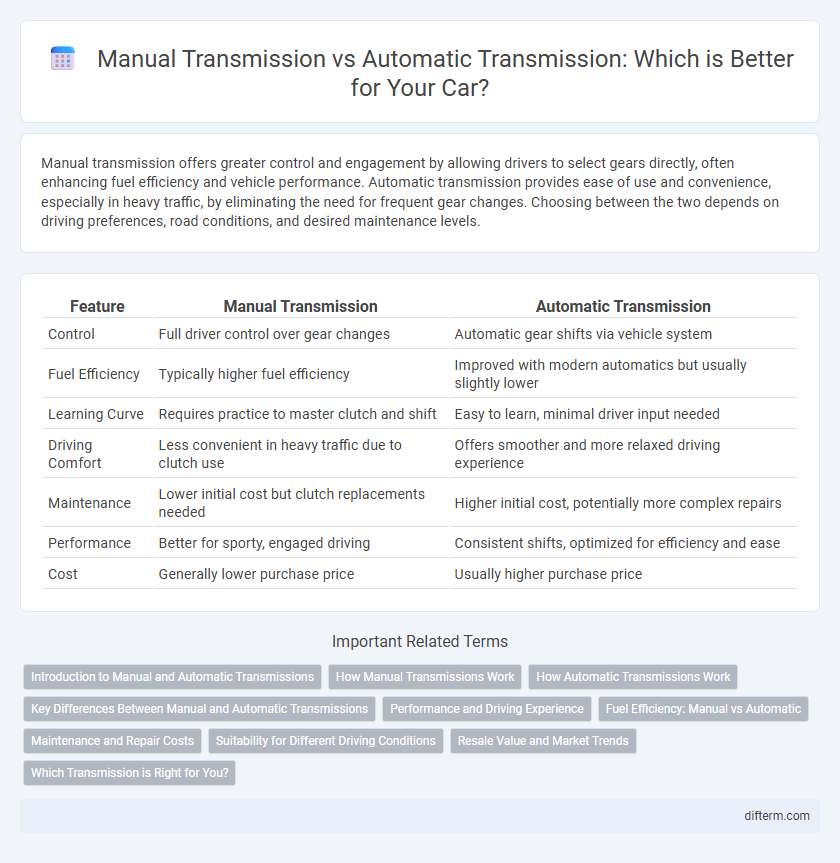Manual transmission offers greater control and engagement by allowing drivers to select gears directly, often enhancing fuel efficiency and vehicle performance. Automatic transmission provides ease of use and convenience, especially in heavy traffic, by eliminating the need for frequent gear changes. Choosing between the two depends on driving preferences, road conditions, and desired maintenance levels.
Table of Comparison
| Feature | Manual Transmission | Automatic Transmission |
|---|---|---|
| Control | Full driver control over gear changes | Automatic gear shifts via vehicle system |
| Fuel Efficiency | Typically higher fuel efficiency | Improved with modern automatics but usually slightly lower |
| Learning Curve | Requires practice to master clutch and shift | Easy to learn, minimal driver input needed |
| Driving Comfort | Less convenient in heavy traffic due to clutch use | Offers smoother and more relaxed driving experience |
| Maintenance | Lower initial cost but clutch replacements needed | Higher initial cost, potentially more complex repairs |
| Performance | Better for sporty, engaged driving | Consistent shifts, optimized for efficiency and ease |
| Cost | Generally lower purchase price | Usually higher purchase price |
Introduction to Manual and Automatic Transmissions
Manual transmissions require drivers to manually select gears using a clutch and gear stick, offering precise control over engine power and fuel efficiency. Automatic transmissions use complex hydraulic systems and sensors to shift gears seamlessly without driver input, enhancing convenience in traffic conditions. Both systems influence vehicle performance, fuel consumption, and maintenance requirements, making the understanding of their mechanisms crucial for automotive decisions.
How Manual Transmissions Work
Manual transmissions function through a driver-operated clutch and gear stick that engage and disengage gears manually, enabling direct control over power delivery from the engine to the wheels. A series of gears of different sizes rotate on parallel shafts; shifting the gear lever moves a selector fork that engages the corresponding gear, allowing torque and speed to be altered according to driving conditions. This mechanical linkage results in higher efficiency and often better fuel economy compared to automatic transmissions, especially in performance and off-road vehicles.
How Automatic Transmissions Work
Automatic transmissions use a complex system of hydraulics, planetary gearsets, and torque converters to automatically select the appropriate gear ratio based on vehicle speed and engine load. The torque converter replaces the clutch in a manual transmission, allowing the engine to continue running while the vehicle is stopped and providing smooth power transfer. Electronic control units (ECUs) manage shift timing and gear selection to optimize fuel efficiency and driving performance.
Key Differences Between Manual and Automatic Transmissions
Manual transmissions require the driver to manually shift gears using a clutch pedal, offering greater control over power delivery and fuel efficiency, which can improve driving performance and reduce maintenance costs. Automatic transmissions use a torque converter and complex hydraulic systems to shift gears automatically, providing ease of use and smoother driving experience, especially in heavy traffic. Key differences include driver involvement, fuel efficiency, maintenance complexity, and initial cost, with manuals generally being cheaper and more efficient, while automatics offer convenience and advanced technology integration.
Performance and Driving Experience
Manual transmissions offer greater control over gear selection, enhancing driver engagement and often improving acceleration responsiveness in performance vehicles. Automatic transmissions provide seamless shifting and ease of use, delivering consistent power delivery ideal for city driving and traffic conditions. Modern dual-clutch automatics blend performance efficiency with quick gear changes, bridging the gap between traditional manual feel and convenience.
Fuel Efficiency: Manual vs Automatic
Manual transmissions often deliver better fuel efficiency compared to automatic transmissions due to their direct control over gear shifts and reduced parasitic loss. Modern automatic transmissions with advanced technologies like continuously variable transmissions (CVTs) and dual-clutch systems have narrowed the fuel efficiency gap significantly. Data from the Environmental Protection Agency (EPA) indicates manual vehicles can achieve up to 5-10% better miles per gallon in city and highway driving under optimal conditions.
Maintenance and Repair Costs
Manual transmissions typically have lower maintenance and repair costs due to their simpler design and fewer components prone to failure. Automatic transmissions involve complex hydraulic systems and electronic controls that can be expensive to service and repair. Regular fluid changes are essential for both types, but automatic transmissions generally require more frequent and costly maintenance.
Suitability for Different Driving Conditions
Manual transmissions offer greater control and engine braking, making them highly suitable for off-road, steep inclines, and performance driving where precision is essential. Automatic transmissions provide seamless gear changes and ease of use, ideal for heavy traffic, urban commuting, and stop-and-go conditions where driver fatigue is a concern. Advanced automatic systems such as dual-clutch and continuously variable transmissions (CVTs) enhance fuel efficiency and adaptability across diverse driving environments.
Resale Value and Market Trends
Manual transmissions generally retain higher resale value among driving enthusiasts and collectors due to their perceived control and driving engagement, though the overall market demand favors automatic transmissions. With automatic transmissions dominating over 90% of new vehicle sales globally, their widespread adoption leads to faster depreciation for manual-equipped cars in average consumer markets. Current market trends indicate a steady decline in manual transmission availability, further solidifying automatics as the more commercially viable option with broader resale appeal.
Which Transmission is Right for You?
Choosing between manual and automatic transmission depends on driving preferences and vehicle use. Manual transmissions offer greater control and fuel efficiency, appealing to enthusiasts who enjoy a tactile driving experience and often drive in varied terrains. Automatic transmissions provide convenience and ease in stop-and-go traffic, making them ideal for daily commuting and urban environments.
manual transmission vs automatic transmission Infographic

 difterm.com
difterm.com